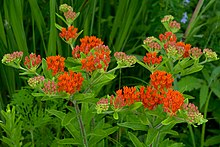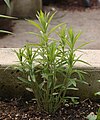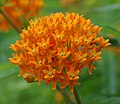Asclepias tuberosa
| Asclepias tuberosa | |
|---|---|

| |
| Scientific classification | |
| Kingdom: | Plantae |
| Clade: | Tracheophytes |
| Clade: | Angiosperms |
| Clade: | Eudicots |
| Clade: | Asterids |
| Order: | Gentianales |
| Family: | Apocynaceae |
| Genus: | Asclepias |
| Species: | A. tuberosa
|
| Binomial name | |
| Asclepias tuberosa | |
| Synonyms[1] | |
| |
Asclepias tuberosa, commonly known as butterfly weed, is a species of milkweed native to eastern and southwestern North America.[2] It is commonly known as butterfly weed because of the butterflies that are attracted to the plant by its color and its copious production of nectar.[3]
Description
[edit]It is a perennial plant growing to 0.3–1 m (1–3+1⁄2 ft) tall. The leaves are spirally arranged, lanceolate, 3–12 cm (1+1⁄4–4+3⁄4 in) long,[4] and 2–3 cm (3⁄4–1+1⁄4 in) broad.
From April to September, in the upper axils, 7.5 cm (3 in)–wide umbels of orange, yellow or red flowers 1.5 cm (1⁄2 in) wide appear. They each have five petals and five sepals.[4] It is uncertain if reddish flowers are due to soil mineral content, ecotype genetic differentiation, or both. A cultivar named 'Hello Yellow' typically has more yellowish flowers than ordinary examples of this plant.
The fruit pod is 7.5–15 cm (3–6 in) long, containing many long-haired seeds.[4]
Similar species
[edit]The plant looks similar to the lanceolate milkweed (Asclepias lanceolata), but is uniquely identified by the larger number of flowers, and the hairy stems that are not milky when broken. It is most commonly found in fields with dry soil. Tropical milkweed (Asclepias curassavica) can resemble Asclepias tuberosa in its red form but also lacks hairy stems.
Taxonomy
[edit]Subspecies
[edit]- Asclepias tuberosa subsp. interior – (Central United States, Ontario and Quebec[5])
- Asclepias tuberosa subsp. rolfsii – Rolfs milkweed (Southeastern United States)
- Asclepias tuberosa subsp. tuberosa – (Eastern United States)
Common names
[edit]Common names include butterfly weed,[6] Canada root, chieger flower,[6] chiggerflower, fluxroot, Indian paintbrush, Indian posy, orange milkweed, orange root,[7] orange Swallow-wort, pleurisy root,[6] silky swallow-wort, tuber root, yellow milkweed, white-root, windroot, butterfly love, butterflyweed, and butterfly milkweed.[8]
Distribution and habitat
[edit]The species can be found from South Dakota south to Texas and Mexico, west to Utah and Arizona, as well as many other areas further east.[4]
This plant favors dry, sand or gravel soil, but has also been reported on stream margins. It requires full sun.
Ecology
[edit]Most easily propagated by seed. The primary pollinators are bees and wasps, rather than butterflies.[9] Sown outdoors after frost, a plant will flower and produce seed in the third year. It is difficult to transplant once established, as it has a deep, woody taproot.[10][11]
A. tuberosa is a larval food plant of the queen and monarch butterflies, as well as the dogbane tiger moth, milkweed tussock moth, and the unexpected cycnia.[3][12] Because of its rough leaves and trichomes, it is not a preferred host plant of the monarch butterfly but caterpillars can be reared on it successfully.[13][14][15] Further, it is one of the very lowest Asclepias species in cardenolide content, making it a poor source of protection from bird predation and parasite virulence and perhaps contributing to its lack of attractiveness to egg-laying monarchs.[16]
Cultivation
[edit]Butterfly weed is frequently grown in gardens for its showy orange flowers which are especially attractive to bees, though also visited by hummingbirds, moths, and butterflies.[17][18] It is easily grown from seeds and is difficult to transplant due to the size of its roots.[19] Grown from seed plants will take about two to three years to reach flowering size in average conditions.[17] The seeds do not require stratification and can be immediately planted, though in commercial growing they are generally moist stratified at 5 °C for 30–60 days because this increases the germination rate.[20][21][22] For other milkweeds a thin layer of mulch a layer 1–2 cm thick increases the germination rate, though specific research on butterfly weed is lacking.[22]
Butterfly weed has few serious pest or disease problems. It is susceptible to crown rot if planted in poorly drained or too constantly moist locations.[17] It is hardy in USDA zones 3–9.[19]
Toxicity
[edit]The plant contains toxic glycosides, alkaloids and resinoids. These can cause weakness, seizures and corneal injuries.[23] Use of the plant is contraindicated in pregnancy, during lactation or with infants due to its toxins, which include resinoids and pregnanes.[24]
Uses
[edit]Native Americans and European pioneers used the boiled roots to treat diarrhea and respiratory illnesses.[25] The young seed pods were used as food after being boiled in several changes of water.[25] The seed pod down was spun and used to make candle wicks.[25]
The root was once used to treat pleurisy.[4]
Gallery
[edit]-
Entire plant from the ground to the flower
-
Young stems during spring
-
A young leaf
-
An emerging flower head
-
Closeup of the hairy stems
-
Closeup of unopened buds
-
Flower head
-
Closeup showing unopened, opening, and fully opened flower buds
-
Orange flowers
-
Red-striped orange flowers
-
Yellow flowers
-
Seedpod
References
[edit]- ^ "Asclepias tuberosa". World Checklist of Selected Plant Families. Royal Botanic Gardens, Kew – via The Plant List. Note that this website has been superseded by World Flora Online
- ^ (1) "Query Page". BONAP’s Taxonomic Data Center (TDC): The Biota of North America Program: North American Vascular Flora.
(2) Stevens, Michelle. "Plant guide for Butterfly Milkweed: Asclepias tuberosa L." (PDF). United States Department of Agriculture: Natural Resources Conservation Service: National Plant Data Center. Archived (PDF) from the original on July 9, 2021. Retrieved July 5, 2021.
(3) Stritch, Larry. "Butterfly Milkweed (Asclepias tuberosa L.)". Plant of the Week. United States Department of Agriculture: United States Forest Service. Archived from the original on March 27, 2021. Retrieved July 9, 2021. - ^ a b (1) Stevens, Michelle. "Plant guide for Butterfly Milkweed: Asclepias tuberosa L." (PDF). United States Department of Agriculture: Natural Resources Conservation Service: National Plant Data Center. Archived (PDF) from the original on July 9, 2021. Retrieved July 5, 2021.
Milkweed species are attractive to many insect species, including the large milkweed bug, common milkweed bug, red milkweed beetle, blue milkweed beetle, and bees.
(2) Mader, Eric; Shepherd, Mathew; Vaughan, Mace; Black, Scott Hoffman; LeBuhn, Gretchen (2011). Attracting Native Pollinators: Protecting North America's Bees and Butterflies: The Xerces Society guide. North Adams, Massachusetts: Storey Publishing. p. 291. ISBN 9781603427470. LCCN 2010043054. OCLC 776997073. Retrieved July 7, 2021 – via Internet Archive. - ^ a b c d e Spellenberg, Richard (2001) [1979]. National Audubon Society Field Guide to North American Wildflowers: Western Region (rev ed.). Knopf. pp. 349–350. ISBN 978-0-375-40233-3.
- ^ Species profile on VASCAN. Retrieved on February 21, 2018.
- ^ a b c "Asclepias tuberosa". Germplasm Resources Information Network. Agricultural Research Service, United States Department of Agriculture. Retrieved December 17, 2017.
- ^ anonymous (2008). "Featured Native Plant: Butterfly Weed" (PDF). Wild Ones: Native Plants, Natural Landscapes. 6 (4). Archived from the original (PDF) on August 14, 2014. Retrieved June 11, 2013.
- ^ Dickinson, T.; Metsger, D.; Bull, J.; & Dickinson, R. (2004) ROM Field Guide to Wildflowers of Ontario. Toronto:Royal Ontario Museum, p. 138.
- ^ Fishbein, M., and D.L. Venable. 1996. Diversity and change in the effective pollinators of Asclepias tuberosa. Ecology 77:1061-1073.
- ^ Loewer, Peter 'Native Perennials For the Southeast' Cool Springs Press. Nashville, Tenn. 2005 ISBN 1-59186-121-7
- ^ Druse, Ken 'Making More Plants The Science, Art, and Joy of Propagation' Abrams. New York, NY. 2012 ISBN 0-517-70787-X
- ^ Schillo, Rebecca (2011). Cummings, Nina (ed.). "Native Landscaping Takes Root in Chicago". In the Field. The Field Museum: 13.
- ^ Pocius, Victoria M.; Debinski, Diane M.; Pleasants, John M.; Bidne, Keith G.; Hellmich, Richard L. (January 8, 2018). "Monarch butterflies do not place all of their eggs in one basket: oviposition on nine Midwestern milkweed species". Ecosphere. 9 (1). Ecological Society of America (ESA): 1–13. Bibcode:2018Ecosp...9E2064P. doi:10.1002/ecs2.2064.
In our study, the least preferred milkweed species A. tuberosa (no choice; Fig. 2) and A. verticillata (choice; Fig. 3A) both have low cardenolide levels recorded in the literature (Roeske et al. 1976, Agrawal et al. 2009, 2015, Rasmann and Agrawal 2011), .... Females may be able to sense these chemical differences by dabbing their ovipositor on the underside of a leaf prior to oviposition (Zalucki et al. , Arikawa ). Additionally, A. tuberosa has a layer of trichomes, which may inhibit oviposition or decrease a female's ability to sense leaf chemicals.
- ^ Gomez, Tony. "Asclepias Tuberosa: Butterfly Weed for Monarchs and More". Monarch Butterfly Garden. Archived from the original on August 16, 2017. Retrieved September 11, 2020.
Rough leaves for monarch caterpillars, not typically a heavily used host plant
. - ^ Butterfly Society of Virginia (2019). "Growing Milkweed". Archived from the original on June 24, 2019. Retrieved December 25, 2023.
I've grown butterfly weed, swamp milkweed, Asclepias currassavica (bloodflower), Asclepias syriaca (common milkweed), and Asclepias verticillata (whorled milkweed). I've found that butterfly weed is the least favorite of my Monarch guests in my Virginia Beach garden for laying eggs (perhaps the leaves are tougher?)
- ^ (1) "Milkweeds (mostly Asclepias spp.)". Alonso Abugattas Shares Native Plant Picks for Wildlife. Mid-Atlantic Gardener. 2016. Archived from the original on March 13, 2017. Retrieved October 17, 2020.
And if you have hot, dry conditions in your yard, try Butterflyweed (A. tuberosa). .... It's the least favored by Monarch caterpillars because it has very little toxin (cardiac glycosides) in its leaves.
(2) Abugattas, Alonzo (January 3, 2017). "Monarch Way Stations". Capital Naturalist. Archived from the original on June 5, 2017. Retrieved June 5, 2017 – via Blogger.(A. tuberosa) is the least favored by monarch caterpillars .... because it has very little toxin (cardiac glycosides) in its leaves, ....
.
(3) "Butterfly Weed: Asclepias tuberosa" (PDF). Becker County, Minnesota: Becker Soil and Water Conservation District. Archived from the original (PDF) on September 11, 2020. Retrieved September 11, 2020.Unlike other milkweeds, this plant has a clear sap, and the level of toxic cardiac glycosides is consistently low (although other toxic compounds may be present).
.
(4) Mikkelsen, Lauge Hjorth; Hamoudi, Hassan; Altuntas Gül, Cigdem; Heegaard, Steffen (2017). "Corneal Toxicity Following Exposure to Asclepias tuberosa". The Open Ophthalmology Journal. 11. Bentham Science Publishers: 1–4. doi:10.2174/1874364101711010001. PMC 5362972. PMID 28400886.The latex of A. tuberosa seems to be different from other members of the Asclepias family due to the fact that even though cardenolides are normally considered present in Asclepias species, these cardenolides have not been found in A. tuberosa. Instead some unique pregnane glycosides are found in A. tuberosa.
(5) Warashina, Tsutomu; Noro, Tadataka (February 2010). "8,12;8,20-Diepoxy-8,14-secopregnane Glycosides from the Aerial Parts of Asclepias tuberosa". Chemical and Pharmaceutical Bulletin. 58 (2). Pharmaceutical Society of Japan: 172–179. doi:10.1248/cpb.58.172. PMID 20118575. Retrieved September 11, 2020.Though cardenolides are considered to be characteristic constituents of Asclepias spp. together with pregnane glycosides, we could find no cardenolides in the more hydrophobic fraction of the methanol extract of the aerial parts of A. tuberosa, the same as previously.
(6) Pocius, Victoria M.; Debinski, Diane M.; Pleasants, John M.; Bidne, Keith G.; Hellmich, Richard L. (January 8, 2018). "Monarch butterflies do not place all of their eggs in one basket: oviposition on nine Midwestern milkweed species". Ecosphere. 9 (1). Ecological Society of America (ESA): 1–13. Bibcode:2018Ecosp...9E2064P. doi:10.1002/ecs2.2064.In our study, the least preferred milkweed species A. tuberosa (no choice; Fig. 2) and A. verticillata (choice; Fig. 3A) both have low cardenolide levels recorded in the literature (Roeske et al. 1976, Agrawal et al. 2009, 2015, Rasmann and Agrawal 2011)
- ^ a b c "Asclepias tuberosa (Butterfly Milkweed, Butterfly Weed, Chieger Flower, Chiggerflower, Common Butterfly-weed, Indian Paintbrush, Milkweed, Pleurisy Root)". North Carolina Extension Gardener Plant Toolbox. North Carolina State University. Retrieved June 10, 2023.
- ^ Baker, Adam M.; Potter, Daniel A. (August 2018). "Colonization and usage of eight milkweed (Asclepias) species by monarch butterflies and bees in urban garden settings". Journal of Insect Conservation. 22 (3–4): 405–418. doi:10.1007/s10841-018-0069-5. S2CID 254600271. Retrieved June 10, 2023.
- ^ a b "Asclepias tuberosa". Missouri Botanical Garden Plant Finder. Missouri Botanical Garden. Retrieved June 10, 2023.
- ^ Swengel, Ann B. (August 1995). "Stalking wild seeds". Horticulture. 73 (7): 42. Retrieved June 10, 2023.
- ^ Lewis, Mary; Chappell, Matthew; Thomas, Paul A; Zhang, Donglin; Greyvenstein, Ockert (2020). "Development of a vegetative propagation protocol for Asclepias tuberosa". Native Plants Journal. 21 (1): 27–34. doi:10.3368/npj.21.1.27.
- ^ a b Landis, Thomas D.; Dumroese, R. Kasten (2015). "Propagating Native Milkweeds for Restoring Monarch Butterfly Habitat" (PDF). International Plant Propagators' Society, Combined Proceedings (2014). 64: 302. Archived (PDF) from the original on March 8, 2021. Retrieved July 11, 2021 – via United States Department of Agriculture: United States Forest Service.
Many sources of milkweed seeds require stratification (cold, moist treatment) before sowing. .... Butterfly milkweed (A. tuberosa) germination increased from 29 to 48 to 62% as stratification duration increased from 0 to 30 to 60 days, respectively (Bir, 1986).
- ^ Multiple sources:
- Elias, Thomas S.; Dykeman, Peter A. (2009) [1982]. Edible Wild Plants: A North American Field Guide to Over 200 Natural Foods. New York: Sterling. pp. 267–68. ISBN 978-1-4027-6715-9. OCLC 244766414.
- Mikkelsen, Lauge Hjorth; Hamoudi, Hassan; Altuntas Gül, Cigdem; Heegaard, Steffen (2017). "Corneal Toxicity Following Exposure to Asclepias tuberosa". The Open Ophthalmology Journal. 11. Bentham Science Publishers: 1–4. doi:10.2174/1874364101711010001. PMC 5362972. PMID 28400886.
The latex of A. tuberosa seems to be different from other members of the Asclepias family due to the fact that even though cardenolides are normally considered present in Asclepias species, these cardenolides have not been found in A. tuberosa. Instead some unique pregnane glycosides are found in A. tuberosa.
- Stevens, Michelle. "Plant guide for Butterfly Milkweed: Asclepias tuberosa L." (PDF). United States Department of Agriculture: Natural Resources Conservation Service: National Plant Data Center. Archived (PDF) from the original on July 9, 2021. Retrieved July 5, 2021.
Milkweed species, as a group, are known to contain cardiac glycosides that are poisonous both to humans and to livestock, as well as other substances that may account for their medicinal effect. Resinoids, glycosides, and a small amount of alkaloids are present in all parts of the plant. Symptoms of poisoning by the cardiac glycosides include dullness, weakness, bloating, inability to stand or walk, high body temperature, rapid and weak pulse, difficulty breathing, dilated pupils, spasms, and coma.
- ^ Multiple sources:
- "Asclepias tuberosa". Native Plant Database. Lady Bird Johnson Wildflower Center, University of Texas at Austin. "Warning: POISONOUS PARTS: Roots, plant sap from all parts. Not edible. Toxic only if eaten in large quantities. Symptoms include vomiting, stupor, weakness, spasms. Toxic Principle: Resinoid, cardiac glycoside" "Lady Bird Johnson Wildflower Center - the University of Texas at Austin". Archived from the original on February 5, 2020. Retrieved October 17, 2020.
{{cite web}}: CS1 maint: bot: original URL status unknown (link). - Mikkelsen, Lauge Hjorth; Hamoudi, Hassan; Altuntas Gül, Cigdem; Heegaard, Steffen (2017). "Corneal Toxicity Following Exposure to Asclepias tuberosa". The Open Ophthalmology Journal. 11. Bentham Science Publishers: 1–4. doi:10.2174/1874364101711010001. PMC 5362972. PMID 28400886.
The latex of A. tuberosa seems to be different from other members of the Asclepias family due to the fact that even though cardenolides are normally considered present in Asclepias species, these cardenolides have not been found in A. tuberosa. Instead some unique pregnane glycosides are found in A. tuberosa.
- Warashina, Tsutomu; Noro, Tadataka (February 2010). "8,12;8,20-Diepoxy-8,14-secopregnane Glycosides from the Aerial Parts of Asclepias tuberosa". Chemical and Pharmaceutical Bulletin. 58 (2). Pharmaceutical Society of Japan: 172–179. doi:10.1248/cpb.58.172. PMID 20118575. Retrieved September 11, 2020.
- "Asclepias tuberosa". Native Plant Database. Lady Bird Johnson Wildflower Center, University of Texas at Austin. "Warning: POISONOUS PARTS: Roots, plant sap from all parts. Not edible. Toxic only if eaten in large quantities. Symptoms include vomiting, stupor, weakness, spasms. Toxic Principle: Resinoid, cardiac glycoside" "Lady Bird Johnson Wildflower Center - the University of Texas at Austin". Archived from the original on February 5, 2020. Retrieved October 17, 2020.
- ^ a b c "Butterfly Weed (Asclepias tuberosa)". tpwd.texas.gov. Retrieved March 6, 2019.
Further reading
[edit]- Peterson, Roger Tory; Margaret McKenny (1968). A Field Guide to Wildflowers of Northeastern and North-central North America. Boston: Houghton Mifflin Company. ISBN 978-0-395-18325-0.
External links
[edit] Media related to Asclepias tuberosa at Wikimedia Commons
Media related to Asclepias tuberosa at Wikimedia Commons Data related to Asclepias tuberosa at Wikispecies
Data related to Asclepias tuberosa at Wikispecies- Butterfly weed brief information and pictures Archived May 14, 2015, at the Wayback Machine
- Missouri Botanical Garden Asclepias tuberosa
- Photo of a J.J. Audubon Plate Clay-Colored Sparrow perched atop Asclepias tuberosa














